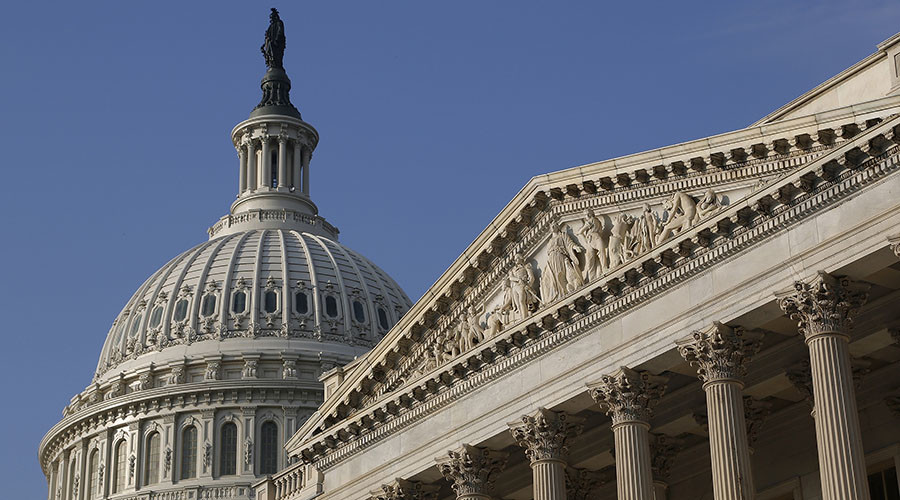
5Background of U.S. Debt
The United States of America (U.S.) holds the largest amount of debt in the world. This should not be a surprise since U.S. is also the country with the largest Gross Domestic Product (GDP). However, what is startling is its rate of growth of its debt as compared to its GDP growth.
Since the Global Financial Crisis (GFC), U.S. as a country have not deleveraged as most of us would have expected. In fact total outstanding credit have increased by c21% from the high of US$55 trillion in 2008, to US$66 trillion at the end of 2016. During the same period of time, U.S. real GDP grew a little over 15%.
Figure 1: US Total Outstanding Credit ballooned by 21% since 2008

Source: U.S. Federal Reserve
U.S. Government taking up the credit binge
To have a better understanding of the debt growth, we breakdown the total outstanding credit by sectors. The main sectors are government, financial institutions, corporates, household and foreign. Looking at the breakdown of the debt, it is clear that the U.S. Government took on a huge amount of debt after 2008. At the end of 2008, the U.S. Government held an approximate 19% of the total credit outstanding. However by the end of 2016, the U.S. Government accounts for approximately 29% of the total credit.
Figure 2: US Government overtook financial sector as the largest debtor

Source: U.S. Federal Reserve, PSR
The increase in U.S. Government debt was largely due to the huge amount of funding needed to stabilised the economy during the aftermath of GFC. At the depth of GFC, the liquidity crunch within the financial system has forced household, corporates and financial sectors to deleverage. In order to maintain the integrity of the financial system and prevent the economy from going into a depression, the U.S. Treasury department, together with the Federal Reserve (Fed), took extra-ordinary measure to inject liquidity into the system via Quantitative Easing (QE).
In Figure 3, which shows the quarter-on-quarter changes in outstanding debt, depict clearly that as household, corporate and financial institutions deleveraged in late 2008, U.S. Government increase their outstanding debt by issuing more U.S. Treasuries.
Figure 3: Government levered up when all other sector deleveraged

Source: U.S. Federal Reserve, PSR
U.S. National Debt Growth
U.S, Government debt, also referred to as the National Debt grew to US$19.9 trillion as at 15 March 2017. This brings the national debt over GDP to well over 105%. The U.S government has never been this leveraged before.
Figure 4: Outstanding National Debt over GDP

Source: St Louis Federal Reserve
U.S. Debt Ceiling
Under the eight years of Obama’s administration, the nation debt grew 69% from US$11.3 trillion. During the eight years, Obama struggled to pull-off any meaning bipartisan agreement with regards to the national debt. Without a full control of the government by Democratic Party, Obama and his administration was constantly at the losing end of any debt negotiation. His regime oversaw the downgrade of U.S. Treasuries by S&P in August 2011 and a Fiscal Impasse in January 2013. This ultimately led to the government shutting down for 16 days between the period of 1 October to 16 October 2013.
A bipartisan agreement was final passed by congress in November 2015. The Bipartisan Budget Act of 2015 will essentially suspend the debt ceiling through till 15 March 2017. On 16 March 2017 the limit will reset to reflect the cumulative borrowing as of then. The new ceiling is estimated to be at US$ 19.85 trillion.
Please sign in to download the full report.
Important Information
This report is prepared and/or distributed by Phillip Securities Research Pte Ltd ("Phillip Securities Research"), which is a holder of a financial adviser’s licence under the Financial Advisers Act, Chapter 110 in Singapore.
By receiving or reading this report, you agree to be bound by the terms and limitations set out below. Any failure to comply with these terms and limitations may constitute a violation of law. This report has been provided to you for personal use only and shall not be reproduced, distributed or published by you in whole or in part, for any purpose. If you have received this report by mistake, please delete or destroy it, and notify the sender immediately.
The information and any analysis, forecasts, projections, expectations and opinions (collectively, the “Research”) contained in this report has been obtained from public sources which Phillip Securities Research believes to be reliable. However, Phillip Securities Research does not make any representation or warranty, express or implied that such information or Research is accurate, complete or appropriate or should be relied upon as such. Any such information or Research contained in this report is subject to change, and Phillip Securities Research shall not have any responsibility to maintain or update the information or Research made available or to supply any corrections, updates or releases in connection therewith.
Any opinions, forecasts, assumptions, estimates, valuations and prices contained in this report are as of the date indicated and are subject to change at any time without prior notice. Past performance of any product referred to in this report is not indicative of future results.
This report does not constitute, and should not be used as a substitute for, tax, legal or investment advice. This report should not be relied upon exclusively or as authoritative, without further being subject to the recipient’s own independent verification and exercise of judgment. The fact that this report has been made available constitutes neither a recommendation to enter into a particular transaction, nor a representation that any product described in this report is suitable or appropriate for the recipient. Recipients should be aware that many of the products, which may be described in this report involve significant risks and may not be suitable for all investors, and that any decision to enter into transactions involving such products should not be made, unless all such risks are understood and an independent determination has been made that such transactions would be appropriate. Any discussion of the risks contained herein with respect to any product should not be considered to be a disclosure of all risks or a complete discussion of such risks.
Nothing in this report shall be construed to be an offer or solicitation for the purchase or sale of any product. Any decision to purchase any product mentioned in this report should take into account existing public information, including any registered prospectus in respect of such product.
Phillip Securities Research, or persons associated with or connected to Phillip Securities Research, including but not limited to its officers, directors, employees or persons involved in the issuance of this report, may provide an array of financial services to a large number of corporations in Singapore and worldwide, including but not limited to commercial / investment banking activities (including sponsorship, financial advisory or underwriting activities), brokerage or securities trading activities. Phillip Securities Research, or persons associated with or connected to Phillip Securities Research, including but not limited to its officers, directors, employees or persons involved in the issuance of this report, may have participated in or invested in transactions with the issuer(s) of the securities mentioned in this report, and may have performed services for or solicited business from such issuers. Additionally, Phillip Securities Research, or persons associated with or connected to Phillip Securities Research, including but not limited to its officers, directors, employees or persons involved in the issuance of this report, may have provided advice or investment services to such companies and investments or related investments, as may be mentioned in this report.
Phillip Securities Research or persons associated with or connected to Phillip Securities Research, including but not limited to its officers, directors, employees or persons involved in the issuance of this report may, from time to time maintain a long or short position in securities referred to herein, or in related futures or options, purchase or sell, make a market in, or engage in any other transaction involving such securities, and earn brokerage or other compensation in respect of the foregoing. Investments will be denominated in various currencies including US dollars and Euro and thus will be subject to any fluctuation in exchange rates between US dollars and Euro or foreign currencies and the currency of your own jurisdiction. Such fluctuations may have an adverse effect on the value, price or income return of the investment.
To the extent permitted by law, Phillip Securities Research, or persons associated with or connected to Phillip Securities Research, including but not limited to its officers, directors, employees or persons involved in the issuance of this report, may at any time engage in any of the above activities as set out above or otherwise hold an interest, whether material or not, in respect of companies and investments or related investments, which may be mentioned in this report. Accordingly, information may be available to Phillip Securities Research, or persons associated with or connected to Phillip Securities Research, including but not limited to its officers, directors, employees or persons involved in the issuance of this report, which is not reflected in this report, and Phillip Securities Research, or persons associated with or connected to Phillip Securities Research, including but not limited to its officers, directors, employees or persons involved in the issuance of this report, may, to the extent permitted by law, have acted upon or used the information prior to or immediately following its publication. Phillip Securities Research, or persons associated with or connected to Phillip Securities Research, including but not limited its officers, directors, employees or persons involved in the issuance of this report, may have issued other material that is inconsistent with, or reach different conclusions from, the contents of this report.
The information, tools and material presented herein are not directed, intended for distribution to or use by, any person or entity in any jurisdiction or country where such distribution, publication, availability or use would be contrary to the applicable law or regulation or which would subject Phillip Securities Research to any registration or licensing or other requirement, or penalty for contravention of such requirements within such jurisdiction.
This report is intended for general circulation only and does not take into account the specific investment objectives, financial situation or particular needs of any particular person. The products mentioned in this report may not be suitable for all investors and a person receiving or reading this report should seek advice from a professional and financial adviser regarding the legal, business, financial, tax and other aspects including the suitability of such products, taking into account the specific investment objectives, financial situation or particular needs of that person, before making a commitment to invest in any of such products.
This report is not intended for distribution, publication to or use by any person in any jurisdiction outside of Singapore or any other jurisdiction as Phillip Securities Research may determine in its absolute discretion.
IMPORTANT DISCLOSURES FOR INCLUDED RESEARCH ANALYSES OR REPORTS OF FOREIGN RESEARCH HOUSE
Where the report contains research analyses or reports from a foreign research house, please note:

Sai Teng covers the global macro research. He has more than 6 years investment experience primarily in portfolio construction and asset allocation. He graduated with Bachelor of Science in Banking and Finance from University of London.